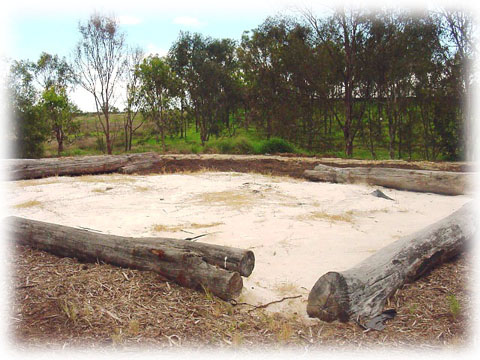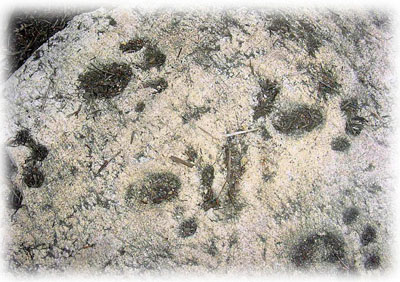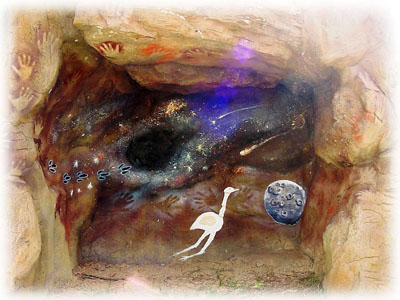Traditional Ceremonial Rituals are used by all Australian people for educational (like school) and religious (like church) purposes. The ceremonies can be very unique and different - how ever, they continue to be practised in exactly the same way in each specific area.
Initiations
This ritual is to teach the young boys and girls of the tribe information about the law, their country and their spiritual beliefs. The Elders of the tribe pass on all of the knowledge that the young need to take their place as an adult in the community. These ceremonies very often are lengthy and sometimes take place over a period of years, in stages of "learning" and "proving". It is a time of instruction, passing down of skills, behaviour and beliefs. These ceremonies take place at the appropriate site for the lesson.
 Handprints are painted during very special ceremonies. They often show the graduation of a person throughout their initiations and learning. Today people have a graduation night and a formal when they finish each level of schooling. Traditionally, Aboriginal people have a very similiar process. The young graduate participates in a graduation ceremony. At this ceremony, the boy will participate in a dance during which an elder will spit ochre over the hand of the initiated. The formal would then be a corroboree (party / dance) that can go on all through the night.
Handprints are painted during very special ceremonies. They often show the graduation of a person throughout their initiations and learning. Today people have a graduation night and a formal when they finish each level of schooling. Traditionally, Aboriginal people have a very similiar process. The young graduate participates in a graduation ceremony. At this ceremony, the boy will participate in a dance during which an elder will spit ochre over the hand of the initiated. The formal would then be a corroboree (party / dance) that can go on all through the night.
 These are emu's paw prints. In the background is the handprint of an emu's totem person and their artefact given to them during their totem intiation.
These are emu's paw prints. In the background is the handprint of an emu's totem person and their artefact given to them during their totem intiation.
 Notice the kangaroo prints which hop over the handprints and boomerang gift given to an initiated man.
Notice the kangaroo prints which hop over the handprints and boomerang gift given to an initiated man.
 This is the head of the rainbow serpent. His body goes all the way across the rock wall (tchambree). He is the only snake painted that will have ears.
This is the head of the rainbow serpent. His body goes all the way across the rock wall (tchambree). He is the only snake painted that will have ears.
Ceremonies
Men and women have very different roles to play in their tribal community. These roles are passed on to each generation to the next, educating young aboriginals on different aspects of the law that the community needs to maintain and respect. This respect and strength of both men and women in their differing yet combined roles is upheld by very strict punishment. Punishment can include spearing and death. These ceremonies take place at meeting places for men and women only.
 These Traditional rock carvings are sacred women's fertility rings. Women wanting to have a baby should rub these to ensure a safe and healthy pregnancy.
These Traditional rock carvings are sacred women's fertility rings. Women wanting to have a baby should rub these to ensure a safe and healthy pregnancy.
 This type of painting is done at a scared women's site. Initiations were held for teaching young girls secret women's business.
This type of painting is done at a scared women's site. Initiations were held for teaching young girls secret women's business.
 This painting is a sign that there is a nearby bora-ring. Because bora-rings are only used by initiated men, this sign serves as a warning to any passers by to stay away.
This painting is a sign that there is a nearby bora-ring. Because bora-rings are only used by initiated men, this sign serves as a warning to any passers by to stay away.
Festive Ceremonies
Festive ceremonies can be for any good reason at all! - They can be for the celebration of a Dreamtime Story, when the whole tribe dances, sings and plays music in the honour of the Ancestral spirit. This spirit is responsible for the way things are of the reason they came to be - just like Christian people celebrating Christmas. Ceremonies are held for initiations (graduation), weddings, feasts (season of specific food) and other similiar occasions that people have a party today. Some of these ceremonies and dances can go for hours and even days.
These ceremonies take place at bora-rings. These rings are often made by carrying sand (often a very long way), to create a very deep circle of sand to dance on.

Dance Religion
Traditional dancing is part of Aboriginal Tradition and Religion. Dancing has been used be all Australian Aboriginal tribes both for ritual purposes and to express and represent many, many facets of their lives and beliefs.
To "own" a particular corroboree is an honour for the Aboriginal people. They are very often passed down within the family, normally to the eldest of the next generation or to the closest or most deserving relative of the original owner.
The dancers play boomerangs, clap sticks and didgeridoos and are dressed with elaborate headwear. People dance, sing and play musical instruments.
Some Aboriginal groups are happy to show the world their culture by performing some dances, although many will be kept "for their eyes only" within their own sacred ceremonies.
 This is a painting of one of the creation gods. He is now believed to be looking over us from above (father sky).
This is a painting of one of the creation gods. He is now believed to be looking over us from above (father sky).
 These paintings show gods of the moon, sun and stars. These paintings were used to teach each generation stories of creation.
These paintings show gods of the moon, sun and stars. These paintings were used to teach each generation stories of creation.
 This represents a lightning god.
This represents a lightning god.
 This is a painting of a storm god.
This is a painting of a storm god.
 The black painting in the middle shows the god of wirly winds (willie-willie)
The black painting in the middle shows the god of wirly winds (willie-willie)
 At the end of each storm, nature allows new growth and new life. Even when something is bad, something good will come out of it. (As an old tree falls over, this allows light for better growth of the little trees underneath).
At the end of each storm, nature allows new growth and new life. Even when something is bad, something good will come out of it. (As an old tree falls over, this allows light for better growth of the little trees underneath).
 This is the wife of the other creator. It is said that her spirit is in the land and her husband's spirit is in the sky.
This is the wife of the other creator. It is said that her spirit is in the land and her husband's spirit is in the sky.
Rock Carvings: This carving shows a picture used to teach boys about hunting. When you learn where the water from rain goes on the way to a water hole, then you know where animals will go to for a drink. Follow the tracks and your hunting is easier.
 Water Hole: These circles represent the water hole.
Water Hole: These circles represent the water hole.
 Streams of water: Some animals will not mix with others at the water hole, but will drink in the flowing streams. These waving lines represent the run of the water.
Streams of water: Some animals will not mix with others at the water hole, but will drink in the flowing streams. These waving lines represent the run of the water.
 Rain clouds and rain: This is a representation of the clouds and rain showing an optimum time to drink, but most importantly, when to hunt. Do not find shelter; find food while it is easier.
Rain clouds and rain: This is a representation of the clouds and rain showing an optimum time to drink, but most importantly, when to hunt. Do not find shelter; find food while it is easier.
 Kangaroos Tracks: Fresh tracks can be followed to the kangaroo.
Kangaroos Tracks: Fresh tracks can be followed to the kangaroo.
 Emu tracks: Fresh tracks can be followed to the emus.
Emu tracks: Fresh tracks can be followed to the emus.
 Goanna Tracks: Fresh tracks can be followed to the goanna.
Goanna Tracks: Fresh tracks can be followed to the goanna.
 Dingo tracks: Dingoes have better senses and can be followed to food.
Dingo tracks: Dingoes have better senses and can be followed to food.
Education
Some paintings and sacred sites around Australia are made to teach important informaton to the younger generations. This information is later tested towards the person's initiation (just like school tests). The children sit down with an elder and learn everyday information for their survival.
 These circles and dots represent that a water hole is nearby. These paintings are like street signs to find water springs, or rock wells.
These circles and dots represent that a water hole is nearby. These paintings are like street signs to find water springs, or rock wells.
 This painting shows a man fishing. Nets are used to catch fish. The nets are made from lots of string being patiently joined together in a very strong pattern.
This painting shows a man fishing. Nets are used to catch fish. The nets are made from lots of string being patiently joined together in a very strong pattern.
 All the paintings of animals are not done to look pretty. The animal is shown for all of its purposes. The spine is highlighted as these bones can be used for hooks, tips and woomera points. The intestines are pointed out for children what parts not to eat. The fillets are shown to teach the children what parts of the fish are given to different people in their clan (group). The best parts are usually given to the elders.
All the paintings of animals are not done to look pretty. The animal is shown for all of its purposes. The spine is highlighted as these bones can be used for hooks, tips and woomera points. The intestines are pointed out for children what parts not to eat. The fillets are shown to teach the children what parts of the fish are given to different people in their clan (group). The best parts are usually given to the elders.
 The picture shows a man throwing a spear with a woomera. He also has a nulla-nulla in his other hand to finish off the animal if his spear only injures it.
The picture shows a man throwing a spear with a woomera. He also has a nulla-nulla in his other hand to finish off the animal if his spear only injures it.
 These joined rings represent meeting places and the journey, on dreaming story, of their local land.
These joined rings represent meeting places and the journey, on dreaming story, of their local land.
Increase Ritual Sites
These rituals highlight the roles of the totems in each family. Each family continues their caring for their animal or plant totem. The totem is looked after by the custodian totemic family. The laws regarding this plant of animal are made and maintained by the family. This ensures that the species is never hunter or eaten to extinction. If the species is becoming endangered the family will ensure the members of their comminity do not continue to eat that food source until they have had a chance to reproduce or regenerate. These ceremonies take place at the sacred site relating to the totem.
This cave is a replica of many sacred sites found throughout Australia. All of the paintings are of emus and the tracks that an emu makes. Dreamtime stories are also told of how an emu was created in the beginning of time. The family of the emu totem would regularly come to this place to initiate the younger generation to ensure that this information continues to be passed on to the next generation. The hand prints show the initiation of each of these people.
